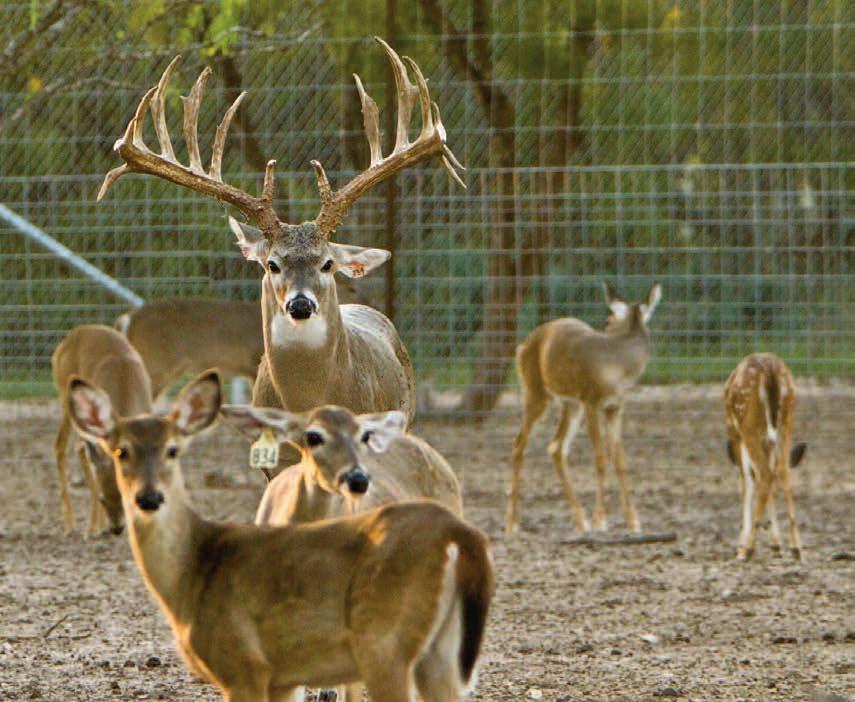
4 minute read
BLOODY BLOATED FAWNS
By Dr Joe Ables, DVM, MA
Nothing is more frustrating than finding a sick fawn. Many questions run through our minds what is going on? Within the first few months of life the number one problem we face with fawns is G.I. problems. A complete physical exam is critical to solve the problem. It is most important to diagnose the problem rather than just treating without knowing the problem. There are tests available to diagnose problems with fawns by examining the feces. First of all, I am not a proponent for doing bacterial cultures in feces. Feces are contaminated and do not yield a pure successful diagnosis and bacterial isolation. Fecal floatation and examination for parasites in feces is the most common and most efficient way to produce a successful diagnosis. Fecal samples can be sent in to TVMDL at parasitologist under the request of parasite screening. Dr Craig at Texas A&M University is one of the top parasitologists in the nation. I have often heard Breeders speak of fecal samples yielding negative results. If you have fecal samples run at a local Veterinarian and the result comes back with negative, you can send the samples into TVMDL for further evaluation.
Advertisement
One of the most common problems we encounter with fawns with bloody diarrhea is coccidia. For years we have treated coccidiosis with many different medications and still have less than 100% response to treatment. I have discovered with multiple fecal examinations run by Texas Veterinary Medical Diagnostic Lab were positive with coccidia but also had Giardia which has been left untreated due to everyone reaching for Corid thus with a response to therapy of 50%. How do we treat Giardia? The texts books tell us that fenbendazoles daily for 5 days have a proven to be effective. Contact your Veterinarian to find the appropriate treatment strategy for your fawns.

Adults typically do not suffer from Giardia nor coccidia and have been commonly found in their GI tracts. Only the adult deer with weakened immune systems appear to have problems fighting these protozoan parasites. Knowing that adults can be "carriers" of these protozoans, how can we prevent the transmission to fawns? Pregnant doe suspected of having these parasites can be evaluated and treated with approved medications a month prior to fawning to prevent transmission.
It is also imperative to do Necropsies on any dead fawns. Samples can be sent in to specifically isolate pathogenic bacteria. Once the bacteria have been isolated a sensitivity test can be accomplished to discover what antibiotics the bacteria are sensitive to. Remember it is very critical to provide pre-and probiotics concurrently to fawns that are under antimicrobial therapy.
Another common problem with experience with fawns is bloating. What causes fawns to bloat? One of the number one causes of bloating in fawns is “ileus.” Ileus is a $10 word for immobility of the intestine. When the small intestines discontinue to contract, air builds up within the intestines causing expansion of the intestinal wall. This forced pressure on the wall occludes(constricts) the blood vessels and prevents oxygen to the nerves, "paralyzing" or numbing the nerves as you have experienced for yourself when sitting Indian Style too long.
Fawns can be "tubed" to help relieve the pressure on the rumen but not the small intestines or colon. Puncturing the left side of the abdomen with a needle only expels air from the rumen as well and can introduce and bacteria to the abdominal cavity producing peritonitis, dead fawns. A few over the counter drugs methods commonly used in veterinarian medicine to relieve GI gas are mineral oil and simethicone (Malachon drops). Mineral oil helps break down the surface tension of gas bubbles and helps decompress the intestines, similar to the use of Malachon drops (simethicone). Other brand names under this category are Gas X, Phazyme, Beano, etc. Also, ask your Veterinarian about “Prokinetics.” Prokinetics are simply what their name implies, forward movement. They help stimulate the nervous system contraction from the stomach to the direction of the colon, which helps push the gas out. Contact your Veterinarian for the correct dosages.
Ok, ready for a recap? Bacteria fermentation can cause gas which causes bloat. The pressure on the intestinal wall can cause terrible pain and is often referred to as colic. Responding quickly to these cases yields the most promising results. Parasites (especially Coccidia) and certain types of bacteria can cause bloody diarrhea. Antibiotics do not treat Protozoan and anti-protozoans do not treat bacteria. A thorough diagnostic and treatment plan is critical for correct therapy. Get ahold of your Veterinarian now to have a plan in action prior to trouble. If you have any questions please feel free to call.
Dr Joe Ables, DVM, MA Enable USA Drjoeables@yahoo.com





